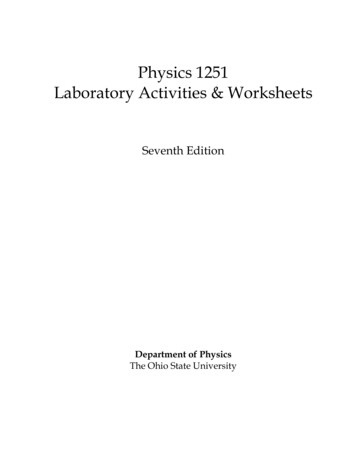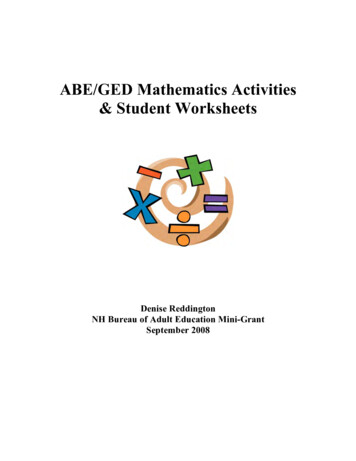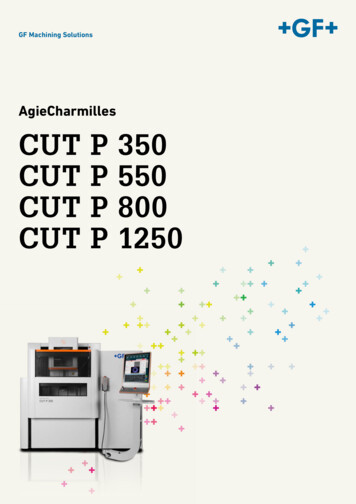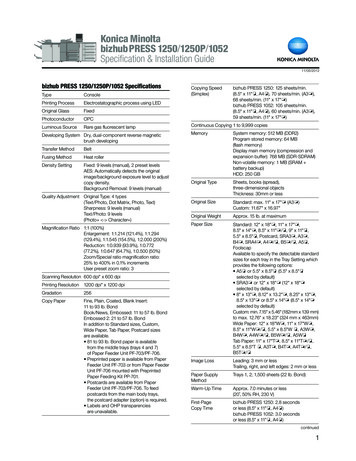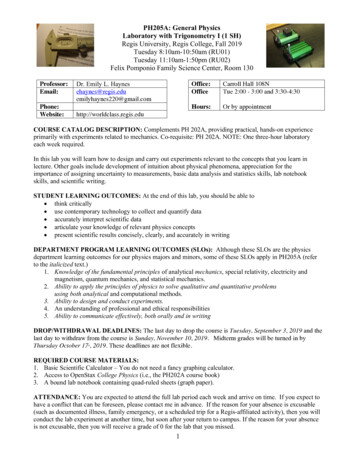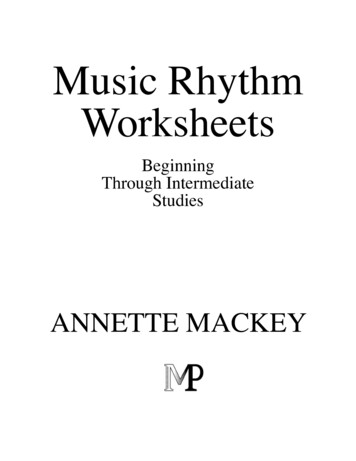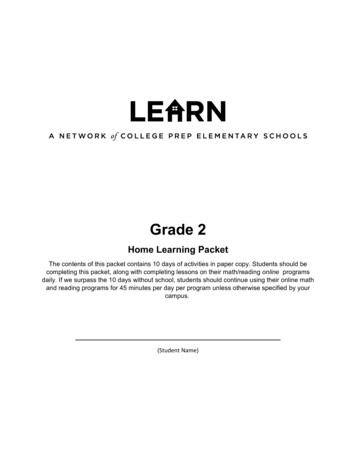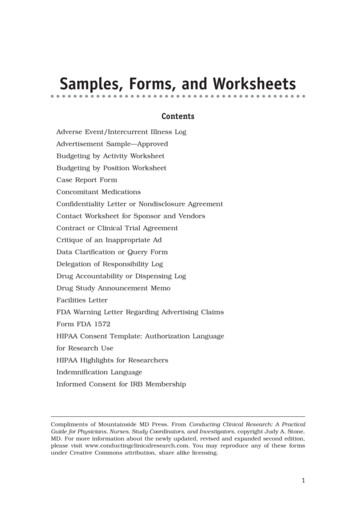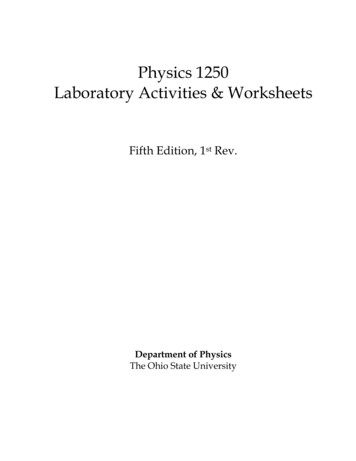
Transcription
Physics 1250Laboratory Activities & WorksheetsFifth Edition, 1st Rev.Department of PhysicsThe Ohio State University
Copyright 2018 by the Department of Physics, The Ohio State UniversityAll rights reserved.Permission in writing must be obtained from the publisher before any part of thiswork may be reproduced or transmitted in any form or by any means, electronic ormechanical, including photocopying and recording, or by any information storageor retrieval system.Printed in the United States of America10 9 8 7 6 5 4 3 2 1ISBN 978-0-7380-7642-3Hayden-McNeil Publishing14903 Pilot DrivePlymouth, MI 48170www.hmpublishing.com
TABLE OF CONTENTSCourse InformationLab InstructionsIntroduction to LoggerProExperiment I –Experiment II –Experiment III –Experiment IV –Experiment V –Experiment VI –Experiment VII –Experiment VIII –Experiment IX –Experiment X –Experiment XI –Experiment XII –Experiment XIII –1-D KinematicsVectors2-D KinematicsDynamic ForcesStatic FrictionConservation of EnergyConservation of MomentumEnergy and MomentumRotational DynamicsVibrationsFluidsHeat EngineSpecial RelativityWorksheetsbackpack goesunder chairi
COURSE INFORMATION: PHYSICS 1250 – 1251Complete course policies are available at the course web y the course manager has the authority to grant excuses.Dr. Michael Ziegler, ziegler.2@osu.edu, SM 1036A, 614-292-2067.University Required StatementPhysics 1250 – 1251 (1240, 1241) are Physical Science courses in the Natural Science category of the GEC. The goals andobjectives for this category are:Goals/Rationale: Students in natural sciences gain understanding of the principles, theories, and methods of modernscience, the relationship between science and technology, the implications of scientific discoveries and the potential ofscience and technology to address problems of the contemporary world.Learning Objectives for Physical Science:1. Students understand the basic facts, principles, theories and methods of modern science.2. Students understand key events in the development of science and recognize that science is an evolving body ofknowledge.3. Students describe the inter-dependence of scientific and technological developments.4. Students recognize social and philosophical implications of scientific discoveries and understand the potential ofscience and technology to address problems of the contemporary world.How the Learning Objectives are Met:1. Student preconceptions and alternate conceptions of physical law are addressed head-on in P125x and P124x. Thisis a necessary component of any contemporary introduction to physics, and is addressed in all components of thecourses.2. Students learn the scientific theories that have developed from the 1600s to the present day. They learn differentmodes of approaching the same phenomena, such as force and energy methods in mechanics.3. Students understand that P125x and P124x introduce the basic physical laws that underlie all engineeringapplications. Examples of applications are provided in the textbook and in demonstrations in lectures.4. Students understand that the social implications lie in the applications, and that in the case of physics the socialimplications are taken up more appropriately in the engineering courses that teach the applications. The reason for thisis that physics does not go into details of how to build instruments or devices.Assignment sheets: Assignment sheets are distributed in the first lecture session of the semester;thereafter, they are available on-line at the P125x and P124x websites, and in a rack next to roomSM 1011V. Assignment sheets include information about required textbooks, specific coursepolicies, and grading.ii
Students with Disability: Please contact the course supervisor at the start of the semester so thatarrangements can be made to accommodate you. Students needing the services provided by theOffice for Disability Services (ODS) will need to be certified by that office. The ODS is located in092L Baker Hall, 113 W. 12th Avenue; 614-292-3307, VRS 614-292-0901; http://www.ods.ohiostate.edu/. ODS sets deadlines to be certified and to register for its services. Failure to meetthe deadlines will result in delayed access to ODS services. The physics department has nocontrol over the deadlines.Tutoring: A free tutoring service is available in SM 1011A and B – see the schedule posted therefor times. A private tutor list is available at http://pgsc.physics.osu.edu/tutors.Academic Misconduct: Not to report academic misconduct is itself regarded as academicmisconduct. Everyone in the university community has a duty to report suspected academicmisconduct.Academic Misconduct in Lab: Students are not always aware of what constitutes properacademic conduct in a laboratory situation. As a general rule, one should not bring into the labany material with data taken at other times, or with any sort of answers written in ahead of time,whether in the lab report or in the lab manual or on any sort of substance, paper or not. Thepresence of any such material in the lab will be considered evidence of intent to commit academicmisconduct. Any such materials used for study prior to the lab should be tucked away wherethey cannot be retrieved easily, in a backpack or other such carrying case. To receive credit, thelab report must be handed in or checked off at the end of the period. If it is removed from the lab,in fairness to other students it cannot be accepted. In no case may a lab report be taken home andbe handed in later.Academic Misconduct in Lecture: When credit is given for use of “clickers”, use of anotherstudent’s clicker to obtain credit for that student must be reported to the Committee on AcademicMisconduct.Academic Misconduct in Recitation: The procedures of the Ohio State University Committee onAcademic Misconduct include the following in the definition of academic misconduct: "Providingor receiving information during quizzes and examinations such as course examinations.". ThePhysics Department refers all suspected cases of academic misconduct to the Committee onAcademic Misconduct and usually follows the committee's recommendations, but there can beexceptions. Exams and quizzes may be photocopied for comparison with exams handed in forregrading. All homework handed in for grading must be your own work. If an exam states thatno notes or books may be used, you must demonstrate to your recitation instructor that yourcalculator memory is clear before the exam begins.Students are permitted to work constructively with other students, and to obtain helpfrom instructors when solving on-line homework problems. Study by cooperative orcollaborative methods is an excellent way to learn and retain understanding. Use of a completesolution or final equation provided by another student, a paid tutor, or any form of web site orconsultation defeats the purpose of the homework assignment, and must be reported to theCommittee on Academic Misconduct by instructors and other students. Posting of or provisionof a complete solution or final equation by any form of transmission to other students, including,but not limited to, those listed above also defeats the purpose of the homework assignment andmust be reported to the Committee on Academic Misconduct.iii
FAST FACTSTime Conflicts:By university rules, no excuses are granted to miss your regular finalexam, midterm, quiz, or lab for an exam, or lab, or any other activity inanother course. The other class must offer you an alternate time.There are no makeup quizzes and labs in this course.Every student is excused for missing two quizzes for any reason including illness, family emergency, aninterview, representing the university, etc. Therefore, no documentation is needed for the first two missedquizzes.Quiz Excuse:Two missed quizzes, or two lowest quizzes, are dropped automatically;missed quizzes are dropped first, regardless of reason. If you miss morethan two quizzes, contact the Course Manager with documentationwithin two weeks, or by the first day of exam week, whichever is first.Lab Excuse:NO DROPS. If you miss a lab, contact the Course Manager withdocumentation within two weeks of the missed lab, or by the first day ofexam week, whichever is first.HW Excuse:HW is typically not excused because at least a week is given to completeeach homework assignment. Deadline extensions are not granted for lastminute illnesses or computer failures. A request for a homework excusemust be made to the Course Manager within two weeks of the missedhomework, or by the first day of exam week, whichever is first.Missed Midterm:No Make-ups. If a student misses a midterm, the student must seekpermission from the Course Manager to be excused for missing themidterm. If the student’s absence is excused, a grade for the missedmidterm will be replaced by a prorated final exam grade. The absencemust be excused within two weeks of the midterm.Missed Final Exam: Permission is required for a makeup exam. A makeup final exam will begiven, if missed for a valid documented reason. Please contact the CourseManager by the last day of exam week to request permission to take amakeup final exam.Early Final Exam:FINAL EXAMS ARE NEVER GIVEN EARLY.Only course supervisors have the authority to grant excuses.COURSE MANAGER: Dr. Michael Ziegler, (ziegler.2@osu.edu), SM 1036A, 614-292-2067.Regrade Requests:These must be submitted within one week of the return of an exam toyou, and no more than two weeks after the exam has been returned to therest of the class, but the last day to summit a request is the first day ofexam week. Regrade requests are not possible for the final exam.Request forms are available on the P125x websites, and in the rack next toroom 1011V Smith Lab. See the document GENERAL COURSE POLICYAND INFORMATION for more detailed information.1/17/19iv
On-Line Homework InstructionsHomework will be submitted and graded via the on-line software package WebAssign. Go tohttps://www.webassign.net/osu/student.html and use your Ohio State name.# and passwordto log in.A registration access code is required to use WebAssign, but at the beginning of the term thereis a grace period of about two weeks in which an access code is not required. An access code isincluded as part of the valuepack with the textbook when a new textbook is purchased from thelocal bookstores or can be purchased through WebAssign’s online store.Problems with WebAssign access: Contact the WebAssign Administrator in the PhysicsDepartment, Dr. Bolland (bolland.1@osu.edu, 614-292-8065). Contact Dr. Bolland ONLY if youbelieve there is a problem with WebAssign itself; consult your recitation instructor or lecturer ora tutor for help with the homework.You may submit answers to part or all of the assignment at any time before its due date. Youget more than one try at most problems, and your goal is to eventually get it right. The numberof tries you have used and may use are shown at the upper left of each problem (click the ).Responses should be either in decimal numbers or the "E" format for scientific notation. Forexample: Enter "0.5" NOT "1/2” or "1E-3" rather than "10 -3".WebAssign checks your answer to see if it is within 1% of the correct answer. As you calculate,you should keep at least 4 significant figures in intermediate steps and enter your answer to atleast 3 significant figures, even if there are fewer significant figures in the problem.WebAssign records the grade for the LAST answer submitted, even if that answer is incorrectand a previous answer is correct.You may work on any assignment up to its due date/time. NO EXTENSIONS will be grantedfor online homework assignments. You may be excused from an online homework assignmentONLY in the following special cases: enrolling late in a course hospitalization or extended illness of the student --- (requires a physician’s note stating thatthe student should be excused from school for that week) death of a parent or sibling military duty for the entire week.Should one of the above special cases arise, contact the course manager with appropriatedocumentation in order to obtain an excuse. Also, if you find that you are not in the databaseand fail to contact the administrator, you will receive zero for your homework grade.v
Lab InstructionsThe two-hour lab session lies at the heart of this course. In it a combination of problemsand laboratory activities is worked in small groups with the assistance of the instructor.These sessions are where you can best learn the material, in order to be able to completethe homework assignments and be prepared for the quizzes and exams that willdetermine your grade. The following are answers to questions you might have.Typically, you and your group will be given a combination of problems and laboratoryactivities to do in a set order. The problems and some of the laboratory activities are notgraded, but some of the laboratory activities may be graded. The graded activities,indicated clearly in this manual, together constitute the “lab score.” Your lecturer willexplain how the lab score combines with other course elements to determine yourgrade.Your group is not expected to finish every problem! We would rather that you work afew problems well with complete understanding than a large number using guesswork.You should record all measurements and calculations in your individual lab manual.(The other members in your group are expected to do the same.) Your instructor mayask to examine it at any time. You are encouraged to ask for help from your instructorat any time. You are welcome to use your textbook and class notes. Also, do not forgetthat you are part of a group. Bring this manual and a scientific calculator to class.Be on time. If you come late, you may not be allowed to perform the lab.Academic Misconduct: (These considerations are in addition to the general Universityrules.) All laboratory work will be done during the laboratory period. Do not bringcompleted lab work to the laboratory. The presence of completed material in the labbook can be considered evidence of intent to commit academic misconduct. Do “gradedactivities” only when your instructor is watching. Do not mistreat the laboratoryequipment -- in particular, do not write on the apparatus. If you are uncertain what ispermitted while doing a given graded lab activity, ask your instructor beforeproceeding.vi
Introduction to LoggerProStart/StopcollectionDefine zeroSet datacollectionparametersAutoscaleData BrowserOpen fileSensorsetupwindowTo start data collection, click the green “Collect” button on the tool bar. There is a delayof a second or two before data collection starts, so don’t try to time clicking the buttonwith your actions.Many parameters in the software are adjustable, like the sample collection time.Adjusting them is done through the menus, but some common commands andparameters are available through the toolbar. For example, click the clock icon tochange the sample rate or time.Often you will be told to load/open a file. Such files will set all the relevant parametersfor the experiment.Graph parameters can be changed by clicking on the graph to select it and using themenus, or by right-clicking on the graph. Common graph commands include zoom andautoscale.If you can’t see your data (the graphs appear blank) or the data is a flat line at zeroyou probably need to adjust the graph scaling. Start with “Autoscale from 0”, thenzoom-in or adjust the axes.If the “collect” button is gray and can’t be clicked then there may be a problem with thesensor hardware. Make sure the cable to the sensor is snapped in place and likewisewith the cables going to the interface box. (The cable from the sensor goes to theinterface box; just follow it.) If the button is still gray, the problem might be thesoftware. Quit out of LoggerPro and restart it.If all else fails, ask your lab instructor for help.vii
Experiment I – 1-D KinematicsThe data collection for this and many other labs use LoggerPro software operating avariety of sensors connected to a LabPro interface. This week’s sensor is a VernierMotion Detector 2. It measures position by emitting pulses of sound and measuring thetime until the reflected sound returns (like radar but with sound waves). You will hear a clicking sound when data collection begins. The detection zone extends about 15-20 to either side of the axis of the beam’scenterline. If some other object or body part gets inside this “cone” it will bedetected instead of the target. A sharp change in the position data may be due tothis. The position detector can measure an object only within the range 15 cm - 6 m. The detector folds open so that the detector can be aimed. Opening the detectorreveals a sensitivity switch with cart and normal (person/ball) settings. Selectingthe appropriate setting will give better data. The default is for the position detector to be the origin or the zero point of an axiswith the positive direction away from the detector. The only thing that is directly measured is position with respect to the detector as afunction of time; the LoggerPro software calculates the velocity and accelerationfrom the position data. This increases the noise in derived values like acceleration.Activity 1Put the detector into the first setup: measuring the cart on the track.Open the file “1-D Kinematics #1”; this file will initialize some parametersand prepare graphs. Level the track so that the cart remains motionless ornearly motionless on the track.Try understanding the graphs for some sample motions. In particular,make sure you can explain the features of the v(t) graph and how it relatesto the x(t) and a(t) graphs.The following are examples of situations you can try: The cart rests motionless at some distance from the detector. After data collection starts, tap the cart so that it moves slowly away from thedetector. Can you identify when the tap started and when it ended? Push the cart steadily to get roughly constant acceleration (difficult). Push the cart back and forth to get oscillatory motion. Can you identify thesign of the acceleration as it changes simply by looking at x(t)? At v(t)?1-D KinematicsI-1
Activity 2For each case below, (1) sketch your best guess for the cart’s motion on thegraphs, then (2) perform the experiment, ideally recording theexperimental results in a different color and (3) reconcile any differences.1. Raise one end of the track to be about 6 cm above the other. Place thedetector at the lower end and the cart near the higher end and releasethe cart.2. Put the detector at the higher end, with the cart also near the higherend, and release the cart.3. With the detector at the higher end, start with the cart near the lowerend and tap it so that it rolls towards the detector, stops before hittingthe detector and then rolls back. You may need to practice a few timesbefore performing the measurement.(1)(2)xxtvxtvtatvtat1-D Kinematics(3)tattI-2
Activity 3Predict the motion of the dropped basketball. The position detector willmeasure the ball’s motion after you drop the ball. The ball will fall andbounce a first time and then bounce a second time while still under thedetector. Your job is to predict the motion starting immediately after thefirst bounce and continuing until just before the second.Open the file “1-D Kinematics #2”. Hold the detector over the floor,pointing downward. Which way is the positive direction?Make your prediction on the leftmost graphs. Once you are ready to dothe experiment, wait for your instructor. Do not drop the basketball withthe computer taking data until you have your instructor’s attention.Sketch the results using the middle graphs below. Sketch only the portionof the motion between the first and second vvtavtatInstructor Initials:1-D KinematicsUse these graphsfor scratch work.tattDate:I-3
1-D Ki
Physics 1250 Laboratory Activities & Worksheets Fifth Edition, 1st Rev. Department of Physics The Ohio State University
